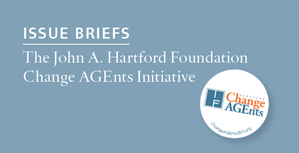 This is the sixth in a series of seven issue briefs.
This is the sixth in a series of seven issue briefs.The John A. Hartford Foundation Change AGEnts Initiative accelerates sustained practice change that improves the care of older adults. It does this by harnessing the collective power of The John A. Hartford Foundation’s interprofessional community of scholars, clinicians, and health system leaders.
In December 2015, nearly 100 John A. Hartford Foundation Change AGEnts gathered in Philadelphia, PA to identify challenges and opportunities for improving care of older adults in several care settings and issue areas. Each group worked toward identifying actionable areas for John A. Hartford Foundation Change AGEnts, the Foundation, and colleagues in the field to pursue. The brief below represents the summary of the Institutional Long-Term Care group’s proceedings and should inform future work to create widespread and systemic changes in the care of older adults.The final issue brief in the series will be published on Health AGEnda in the coming weeks.
Institutional Long-Term Care
 In the 1999 Olmstead Decision, the U.S. Supreme Court upheld the right of individuals to receive care in the community, as opposed to an institution, whenever possible. This decision has enabled significant growth in a range of home- and community-based services for older people. Nevertheless, nearly 1.5 million people, mostly women and the so-called oldest-old, still reside in skilled nursing facilities today. Improving institutional long-term care continues to be a challenge, as the broader health care system evolves and skilled nursing facilities struggle with staffing, care quality, and payment issues.
In the 1999 Olmstead Decision, the U.S. Supreme Court upheld the right of individuals to receive care in the community, as opposed to an institution, whenever possible. This decision has enabled significant growth in a range of home- and community-based services for older people. Nevertheless, nearly 1.5 million people, mostly women and the so-called oldest-old, still reside in skilled nursing facilities today. Improving institutional long-term care continues to be a challenge, as the broader health care system evolves and skilled nursing facilities struggle with staffing, care quality, and payment issues.
The issue group on Institutional Long-Term Care met as the Centers for Medicare and Medicaid Services (CMS) considered a proposed rule that will update regulatory policies governing the provision of care in long-term care facilities. According to CMS, the Consolidated Medicare and Medicaid regulations have not been systematically reviewed and updated since 1991, despite considerable changes in case-mix, resident acuity, and condition intensity, as well as a plethora of quality of care concerns.
Against this backdrop and the opportunities it suggests, the group covered a wide range of issues—some directly affected by the CMS review, others focused on related topics. Notably, there was recognition that institutional or residential care today must be understood within a broader care continuum that includes acute care and home and community-based services (the topic of the final issue brief). The work ahead, therefore, is not just about enhancing what happens in skilled nursing or rehabilitation facilities, but about improving all kinds of long-term services and supports for older, frail, chronically and seriously ill people.
 Challenges
Challenges
Several major learnings and associated challenges emerged from the group’s discussion. These included:
- Confronting ageism and negative stereotypes of long-term care. There was a recognition among the group that ageist attitudes impede our ability to build support for a range of improvements in the care of older adults, both in long-term care facilities and in other places. “Who among us wants to grow old?” asked one group member. These unhelpful, ingrained stereotypes are amplified in long-term care, where the general public too often views long-term care facilities and their staff negatively.
- Promoting culture change in skilled nursing and other long-term settings. Traditional nursing homes, many formed in the middle of the last century, created needed residences and services for older people. These institutional settings, however, evolved into places too often designed around schedules and processes that matter more to the facility than the older adults who reside there. During the last 15 years, the Pioneer Network, the Green House Project, and others have started a “culture change” movement, seeking to create institutional long-term care that is based on person-directed values and practices and where the voices of older adults and those working with them are considered and respected. Improving care in this way involves a diverse set of practical reforms. Group members noted several examples of practical reforms: consistent assignment, shift huddles, use of staff learning circles, involving certified nurses aides (CNAs) in care conferences, and fostering facility-wide commitment to ongoing quality improvements that enhance the patient experience and lift the standard of care.
- Promoting substantive workforce reform. Central to improved care for older people in institutional settings are the clinical and other support staff who work there. Turnover remains a significant issue, with some estimates of average annual turnover rates for registered nurses (RNs), licensed vocational nurses (LVNs), and CNAs ranging between 55 percent and 75 percent. Creating opportunities for career advancement and leadership development, improving pay, developing certificates/certification for aides, and ensuring 24/7 RN coverage in long-term care facilities—all represent strategies to improve the supply and retention of long-term care clinicians and staff.
- Managing safety vs. autonomy. While person-directed care is a critical goal for institutional long-term care, residents and families can nevertheless have discordant views on what that means. Families want safety for their loved ones. Residents want autonomy and choice. Long-term care reforms, including those seeking culture change, must balance this tension to create settings of care that meet the needs and goals of older adults and their families.
- Need for a practice change champion. Previous reforms (e.g., “Hand in Hand” from CMS) included helpful toolkits, but there was insufficient attention paid to who would champion these efforts and how the change process would be managed at individual facilities. Practice change initiatives, including those led by John A. Hartford Foundation Change AGEnts, must ensure buy-in from the Director of Nursing or Chief Nursing Officer and/or administrative leadership so that evidence-based programs are implemented in a meaningful way.
 Opportunities
Opportunities
While the challenges facing institutional long-term care are significant, several ideas for positive action emerged:
- Responding to the final CMS rule on long-term care. The John A. Hartford Foundation Change AGEnts and other practice change advocates should be involved in developing interpretive guidelines based on what emerges as the final CMS rule. In particular, regulations focused on improving person-centered care should be acknowledged and promoted. Beyond the CMS rule itself, there is a need for a mechanism that helps care providers in long-term care facilities stay informed about how changing regulations affect direct care to older adults. Researchers, educators, health plan administrators, and families have similar information needs of their own. Creating an online resource/set of resources to keep the field (and Change AGEnts) abreast of a whole range of policy developments in long-term care would yield significant benefits.
- Developing a compelling and shared change vision. While there are a significant number of people and groups in the Change AGEnts community and beyond working on this issue, the group noted that there is not, at present, a compelling, comprehensive change vision that is widely accepted and can create a sense of urgency around improving long-term care. This gap represents a powerful opportunity.
- Shaping quality improvement efforts to benefit from population level payments through ACOs, bundled payments, value-based purchasing, and other capitated arrangements. Financing issues for long-term care remain critical. How can payments be structured to promote better care? What is the best way to align value propositions so they work both for health care systems and long-term care facilities? There are many quality initiatives and models, but less understanding of what the financial return on investment is for systems and payers. Developing these business cases will be critical to moving useful change forward.
- Advocating for 24/7 RN Coverage. There is the potential to institute 24/7 RN coverage in long-term care through a current bill, H.R. 952—“Put a Registered Nurse in the Nursing Home Act of 2015.” There is a guiding coalition behind this legislation, but assistance is needed to communicate the vision, generate short-term wins that will drive bipartisan and bicameral support, and continue momentum to develop backing for this legislation.
Driving movement to person-centered care
The challenges—ranging from confronting ageist misperceptions about long-term care among the public to reforming working conditions in facilities so they attract and retain the best staff—are formidable, but so are the opportunities. The new regulations that emerge from the CMS review present a tremendous opening for The John A. Hartford Foundation Change AGEnts to drive movement from outdated institutional solutions to person-centered, home and community-based, long-term services and supports for older adults.
Institutional Long-Term Care Issue Group Participants
J Taylor Harden, RN, PhD, FGSA, FAAN (Senior Respondent)
National Hartford Center
of Gerontological Excellence/GSA
Angelia Bowman, MS, MSPM (Facilitator)
Hartford Change AGEnts Initiative
The Gerontological Society of America
Gena Schoen (Notetaker)
Hartford Change AGEnts Initiative
The Gerontological Society of America
Heather Altman, MPH
UNC School of Public Health
Carol Woods Retirement Community
Erica Anderson, MA
The National Committee for Quality Assurance
Evelyn Duffy, DNP, AGPCNP-BC
Case Western Reserve University
Jackie Eaton, PhD
University of Utah
Sharon Foerster, MSW
MaineHealth
Cathy Lieblich, MA
Pioneer Network
Whitney Mills, PhD
Michael E. DeBakey VA Medical Center
Baylor College of Medicine
Ginny Pepper, PhD, RN
University of Utah
Teri Round, BSN, MS, RN, NE-BC
Oklahoma University Health Science Center,
College of Nursing
Harry Strothers, MD
Morehouse School of Medicine
Read the previous posts in The John A. Hartford Foundation Change AGEnts Issue Briefs series:
